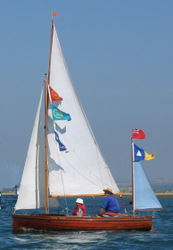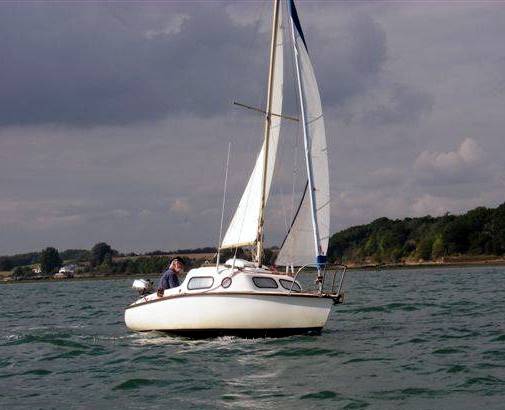Practical Dinghy Cruiser.

The book begins at the beginning by asking Who Cruises? and What is Dinghy Cruising? It then has half dozen short snippets from cruise accounts by people sailing in small (one is an inflatable) boats ... men, women, on the sea, on lakes, crossing the Channel, in Wales, Scotland, Sweden and it makes the point that this is a sport bounded only by the wishes, ambitions and imagination of the people who participate in it.
The next question is Can I do it? It goes on to recommend ways of finding out more and asks you, the reader, what kind of dinghy cruising you might like if you were to take it up, for there are many ways to dinghy cruise.
The picture of Ian & William Hylton used on the cover of the second edition was taken by Liz Baker.

To become involved you would want to know more about the boats and so the book moves on to a discussion of the different styles of craft, the way each one works and how to evaluate one against the another, to find the qualities that you might need, to pursue your kind of sailing. There is a wealth of useful weight, length, size, comparisons and the reader is encouraged to make their own judgements. It mentions different classes of boat and explains exactly what it might feel like to try to live aboard a small craft.
The author then explains how he found a boat that had been 'lost'. It was in a poor condition and from this starting point with no real knowledge of dinghy cruising he began work, to slowly evolve the many different systems needed to make this boat into a craft suitable for sailing and exploring. The sleeping arrangements, the cooking system, engines and propulsion, the equipment he gathered together and the modifications he made are clearly explained with many diagrams (see example below right) and photographs. How do you make a tent? What shape should it be? Where do you find the materials? What size of anchor and what length its warp? Launching? Trailing? The answers are here and there is a comprehensive discussion about Safety recommendations.

 Whilst this is mainly one person's experiences, the reader is also introduced to the Dinghy Cruising Association (DCA). This is the National body for the sport that has been in existence for about 60 years. During that time the Association has produced quarterly bulletins discussing every last little detail of dinghy cruising. They have amassed an unrivalled body of knowledge and also added a sailing library covering almost every book written about all types of sailing.
Whilst this is mainly one person's experiences, the reader is also introduced to the Dinghy Cruising Association (DCA). This is the National body for the sport that has been in existence for about 60 years. During that time the Association has produced quarterly bulletins discussing every last little detail of dinghy cruising. They have amassed an unrivalled body of knowledge and also added a sailing library covering almost every book written about all types of sailing.
Sprinkled through Practical Dinghy Cruiser are many references to the DCA's articles that further expand the relevant information and add the experiences of numerous different people, in different boats, in different locations. The book acts as an initial guide to accessing this DCA information. On the back cover it says, this book is the key to unlocking the whole experience of dinghy cruising, and so it is. It further explains how any reader can access the DCA's 50 years worth of dinghy cruising wisdom, immediately.
The book concludes with some short cruise accounts that illustrate the sailing flexibility offered by the sport. The boat on its trailer can rapidly travel the length of the country, even go overseas. It can be used to explore long river systems, access inland lakes or partake in seagoing adventures. Dinghy cruisers will find themselves enjoying the sunrise, admiring the sunset and seeing the stars once more. The contents of the book will hopefully encourage the more adventurous reader to feel 'I could do that.' And with this book ... they can.
On this page.
Above: Aiden de la Mare's 'Jady Lane' is flying the distinctive DCA burgee below the ensign on its mizzen mast.
The superb sketches (see top right) that introduce each chapter are the work of David Summerville
Below: Chris Hieke's lovely photograph is a reminder of annual DCA rallies at Holy Island. A cropped version of this picture was used on the cover of the First Edition of Practical Dinghy Cruiser. That book has always sold at increased prices secondhand. It usually costs just under £30 on Amazon, for a marked price of £9.99.


Certain very small cruisers can be described
as 'dinghies with lids'. This is a 15ft Sunspot
called 'The Genie' being sailed by Ted Jones.
The qualities of such craft are described and
compared with the open dinghys for they are
sometimes a preferred solution for some
small boat cruisers.